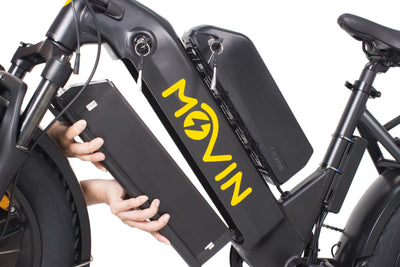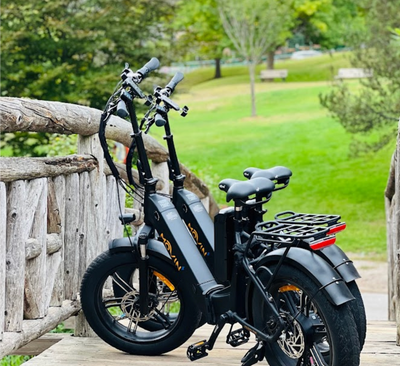Electric bike riders know that the battery is the heart of their ride. But not all e-bike batteries are created equal. Lead acid vs lithium ion is a long-running debate, especially for Canadian riders dealing with frigid winters in Montreal or steep hills in Vancouver. Which battery type can handle subzero temperatures, power through hilly terrain, and offer the best value? In this article, we compare lead acid batteries vs lithium-ion batteries for e-bikes, weighing their pros and cons in real-world Canadian conditions. The goal: help you choose wisely (spoiler alert: lithium-ion is poised to win, and for good reason).
Lead Acid Batteries: The Old Workhorse
Lead-acid batteries are the granddaddies of rechargeable tech, dating back to the 19th century. They had their heyday in early electric bikes and scooters mainly because of one big perk: low upfront cost. If you’re on a tight budget, a lead-acid battery pack might seem tempting – these batteries are cheap to produce and purchase, and they were used in older e-bikes largely to keep costs down.
However, those savings come with major drawbacks. Weight is the first issue: a typical lead-acid e-bike battery is roughly three times heavier than a lithium-ion battery of similar capacity. One estimate found a 6 lb lithium pack can deliver about the same range as a 30 lb lead-acid pack of equal voltage. That extra bulk makes an e-bike harder to pedal and carry, and it limits where the battery can be mounted.
Lead-acid batteries also have a shorter lifespan and lower efficiency. They might endure around 200–300 charge cycles at best (perhaps a year or two of daily use) before their capacity fades noticeably. They also self-discharge faster when sitting idle. And as a lead battery drains, its voltage sags – riders often notice the bike feeling sluggish once the charge falls below about half. In cold weather, these issues intensify. In freezing temperatures, a lead-acid’s available capacity can plummet (car lead batteries, for example, can lose roughly 50% of their power at -18 °C), leading to severely reduced range and performance on winter rides.
Maintenance needs are higher, too. While sealed lead-acid (SLA) batteries don’t require adding water, they do need careful charging habits. They charge slowly – often 5–8 hours to full – and they don’t like being deeply discharged. Leaving a lead battery empty or not charging it regularly can shorten its life even more. Overall, a lead-acid battery can get an e-bike moving on the cheap, but it comes with a lot of baggage (literally and figuratively).
Lithium-Ion Batteries: The Modern Standard
Lithium-ion (Li-ion) batteries are the go-to power source for virtually all modern electric bikes – and for good reason. These high-energy batteries pack a lot of power into a relatively lightweight package. A typical lithium-ion e-bike battery might weigh only 6–7 pounds while delivering the same (or greater) range as a 20+ pound lead-acid battery. For riders tackling steep hills in Vancouver or carrying bikes upstairs, that weight difference is a game-changer.
Li-ion batteries also offer strong performance throughout their discharge cycle. Your e-bike will stay zippy even when the battery is down to 20% charge, whereas a lead battery might start to struggle long before that. They can supply high current without the severe voltage drop that plagues lead-acid under load – meaning better acceleration and hill-climbing power when you need it.
When it comes to longevity, lithium-ion wins hands down. A quality Li-ion pack can handle around 500 to 1,000 full charge cycles (several years of typical use) before its capacity drops significantly. That’s at least double the lifespan of most lead-acid batteries. And charging time is much faster: with the same charger, a lithium-ion battery can recharge about 3–4× faster than a similar lead-acid.
Li-ion batteries perform better in the cold as well. They do lose some range in subzero temperatures, but they’ll still deliver usable power where lead-acid might falter. As one industry expert quipped, you’d need liquid nitrogen–level cold to make a lithium battery perform as poorly as a lead-acid does at room temperature. In short, a good lithium-ion pack will keep you moving even during a Canadian cold snap (just avoid charging it below 0 °C and try to store it indoors before a winter ride).
Lead Acid vs Lithium Ion: Key Differences
Let’s put the difference between lithium and lithium-ion (in the e-bike context) and lead-acid into perspective. The following table highlights the key differences across various factors:
|
Factor |
Lead Acid Battery |
Lithium-Ion Battery |
Lithium (Non-Rechargeable) |
|
Rechargeable? |
Yes (rechargeable) |
Yes (rechargeable) |
No (single-use) |
|
Weight (for same output) |
Very heavy (≈3× heavier than Li-ion) |
~1/3 the weight of lead-acid |
N/A (not used in e-bikes) |
|
Energy Density (Wh/kg) |
Low (~30–40 Wh/kg) |
High (~100–150 Wh/kg) |
Very high (but not rechargeable) |
|
Typical Lifespan |
~200–300 charge cycles (short life) |
~500–1000 charge cycles (long life) |
– (not applicable) |
|
Cold Weather Performance |
Poor – drastic capacity loss in cold (often ~50% loss by -18 °C) |
Better – some capacity loss (~20–30%) but still functional |
– |
|
Charge Time |
Slow – 5–8 hours (cannot fast-charge) |
Fast – ~1/3 the time of lead-acid |
– |
|
Maintenance |
High – frequent charging, avoid full discharges |
Low – just charge and go (built-in BMS manages battery) |
– |
|
Environmental Impact |
Contains toxic lead & acid; must be recycled |
No lead or acid; recycling programs emerging for Li-ion |
– |
* Note: The Lithium (non-rechargeable) column refers to primary lithium-metal batteries (not used in e-bikes). All e-bike lithium batteries are of the rechargeable lithium-ion type.
As you can see from the table above, lithium-ion comes out on top in almost every category. Lead-acid’s only real advantage is its lower purchase price, but that short-term savings is usually outweighed by lithium-ion’s far longer lifespan and superior performance. It’s no surprise that virtually all new e-bikes today run on lithium-ion batteries rather than lead-acid.
Real-World Ride Test: Canadian Conditions
Frigid Winter Commute (Montreal): In a deep winter freeze (around -15 °C), a lithium-ion e-bike battery will still function (with maybe a 20–30% temporary range drop), whereas a lead-acid battery might barely deliver any power. Cold hits lead-acid especially hard, often slashing its effective capacity by half or more. For winter riding, lithium-ion clearly holds up better – and it’s wise to start with a warm battery (store it indoors until you head out).
Climbing Hills (Vancouver): On Vancouver’s steep hills, every pound matters. A lithium-ion battery’s lighter weight makes your e-bike much easier to pedal uphill. Plus, even if your Li-ion battery is only half-charged, it can still deliver near-full power to help you conquer the climb. A lead-acid battery not only adds significant weight (making the ascent tougher), but also suffers from voltage sag as it drains – meaning a half-empty lead battery struggles to provide the boost you need on an incline.
Long-Distance Ride (Prairies): On the flat open roads of the Prairies, range is king. Here lithium-ion’s higher energy density shines – you can carry a lot more energy without a ton of extra weight. Riders can even use dual lithium battery packs for extended 100+ km journeys. Attempting similar range with lead-acid would add so much weight it becomes impractical. Moreover, under continuous draw, lead-acid batteries often deliver less than their rated capacity, so you might run out of juice sooner than expected. For long-distance treks, lithium-ion is the only sensible choice.
Why Movin’ Ebikes Bets on Lithium-Ion
At Movin’ Ebikes, we’ve fully embraced lithium-ion technology for all the reasons above. Our e-bikes exclusively use UL-certified Samsung lithium-ion batteries – a choice that reflects our commitment to safety and performance. (UL certification means each battery model has passed rigorous independent safety tests, so you can charge and ride with peace of mind.) For you as a rider, this translates into reliable power whether you’re braving a Toronto winter commute or enjoying a summer trail ride.
We also make it easy to extend your range. For example, our Movin’ Pulse e-bike supports a Samsung 48V20Ah main battery and an optional Samsung 48V10Ah secondary battery for extra-long journeys. These battery packs lock securely onto the bike yet are simple to remove for indoor charging – a convenient feature on cold Canadian nights.
In the end, when comparing lead acid vs lithium ion for e-bikes, the verdict is clear. Lithium-ion offers lighter weight, longer life, and better performance – especially crucial in Canada’s climate – and that’s why it reigns as the best e-bike battery today. It’s the power source that keeps you moving forward.
Frequently Asked Questions
Can you recharge lithium batteries in e-bikes?
Absolutely! Every lithium battery powering an e-bike is designed to be recharged – hundreds of times, in fact. These are specifically lithium-ion packs, built for daily charging cycles. (While single-use lithium batteries exist, you won’t find them in any quality e-bike.)
What’s the real difference between a "lithium battery" and "lithium-ion battery"?
Here’s the deal: when people say "lithium battery," they’re usually talking about disposable, non-rechargeable types (like in some cameras). But your e-bike? It runs on lithium-ion – the rechargeable champ. So yes, every "lithium" e-bike battery is actually lithium-ion. No single-use surprises here!
Which battery actually lasts longer – lead-acid or lithium-ion?
Lithium-ion wins hands-down for longevity. A typical lead-acid e-bike battery might start fading after just 1-2 years (or 200-300 charges), especially under Canadian weather stress. A well-built lithium-ion pack? It’ll keep you rolling strong for 3-5 years (500+ charges) before you notice a dip. Treat it right (especially in winter), and that gap widens even more. Lead-acid just can’t keep up.
Will my lithium-ion e-bike battery survive a Canadian winter?
A: Yes, but be smart about the cold. Lithium-ion works in winter, but expect a 20-30% temporary range drop on those -15°C days. Your bike will still move, just with less zip on hills. Pro tip: Store the battery indoors overnight and only pop it on your bike when you’re ready to ride. Never charge it while frozen. Thousands of Canadians ride year-round with lithium-ion – it’s all about respecting the cold!
Why are almost all new e-bikes using lithium-ion instead of lead-acid now?
Because lithium-ion batteries offer a far better experience. They pack more energy in less weight, last much longer, and charge faster. As costs have come down, nearly every manufacturer has switched to lithium-ion for these benefits. Lead-acid batteries make e-bikes heavy, short-ranged, and need frequent replacement – not what modern riders want.



